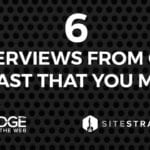Our special guest for episode 368 of the award-winning EDGE of the Web podcast was guest Jeroen Corthout, Co-founder and CEO of Salesflare. Host Erin Sparks spoke with Jeroen about putting the human element into sales automation. Here’s what we learned:
Jeroen Corthout: His Background and Experience

Jeroen Courthout is a Co-Founder and the CEO Salesflare, an intelligent CRM software platform geared toward startups and small businesses. Salesflare’s mission is to automate everything in sales, except for the irreplaceable human contact. It gathers this information from emails, email signatures, social profiles, and more, and everything automatically appears in your address book.
Previous to Salesflare, Jeroen worked in a marketing consulting company focused on the pharmaceutical industry. Salesforce was the CRM being used in the company, but Jeroen and the other salespeople in the company found it wasn’t really helping them do their jobs as much as they thought it would. It was great for reporting capabilities, but not for actually facilitating sales.
When he was later working at a business intelligence company and they got a lot of leads from a particular conference, Jeroen knew Salesforce wasn’t going to help them work with those leads. They looked into any number of CRM platforms and realized none of them were a good fit because they required too much robot-like discipline in initial data entry. Most salespeople aren’t good at that, so why not build a system that’s not dependent on that kind of hardcore data entry on the part of salespeople. That information all exists elsewhere, so why not automate pulling it into the CRM software? It also automates notifications for following up with leads at particular times. Salesflare solves the pain points of salespeople around data and workflow of leads.
The Beauty of Automation in CRM
Automating various tracking functions was something Salesflare dealt with early on its development. When Jeroen was in the business intelligence space, leads in that industry move very slowly on a long time horizon, so it was especially important to keep track of how leads were or were not engaging and with what content.
Salesflare allows for the placement of a pixel in email messages so you’ll automatically know if a lead has opened it. It will also automatically replace any links in the email message with identifiable links for tracking purposes. And it also tracks whether leads visit your website and what they look at when the do visit. So all of these elements come into play in the reporting and scoring of a lead. The scoring is simple: Room Temperature, Hot, or On Fire. And Salesflare automatically sends a notification when the rating or “score” changes from one category to another. If you need more robust website tracking from a marketing perspective, use Google Analytics. Salesflare isn’t trying to be one of those platforms that does everything, because those platforms tend to end up doing nothing.
The data input automation is the key differentiating factor that separates Salesflare from the whole sea of other CRM offerings out there. No one else starts with that key feature of automating the data input, which is a huge win for salespeople. Another differentiating factor they spend a long time developing was ease of use because that can be a factor that drives many salespeople to not use whatever CRM system their company has adopted. And Salesflare currently ranks #5 of all CRMs globally for ease of use. And more automation is in the pipeline at Salesflare, including email sequences (due to be released in April).
It’s also very telling that “customer management” is not what’s highlighted in the name of Salesflare. What it emphasizes is sales. And that’s important because way too many CRMs available in the market don’t actually help salespeople make sales. After all, the point of all CRM efforts is in fact to make sales, and Saleflare keeps that front and center all the time.
The Limits of Automation
It seems like there are also some risks that come with automation. For example, the increasing number of digital natives (Millennials and more recent generations who have grown up steeped in digital technologies) who so naturally can find their way around interfaces of all types often means they can “smell” automation from a mile away and don’t want to feel like they’re being “auto-manipulated.” How can we keep the human element alive in the midst of all this automation and machine learning and artificial intelligence?
For Jeroen in terms of developing a CRM software platform, before automating anything it’s about having had the experience of doing it all manually in order to fully understand the human elements from a human perspective. The rush to automation is when this is bypassed and the resulting software just isn’t good enough. There is lots of automation developed that makes absolutely no sense at all, and it’s because it was done by someone who didn’t understand the humans who would be using it when it was automated. That’s just bad design from a flawed development process.
Automation done well should actually elevate the human element. The idea is to automate away all the pieces of the puzzle that get in the way of salespeople and marketers focusing on that all-important human element. There can be no “set it and forget it” because that means you’re walking away from that human element, which is ultimately and inevitably counterproductive. Let the computers do what they’re good at so the humans can do what they’re good at, which is the conversations and human connection. The goal of automation in Salesflare is to allow salespeople to spend more quality time with more customers.
Remote Selling During a Global Pandemic
For the most part, all sales have gone remote and yet leads still need to be generated. Jeroen notes that the classic concept of “inside sales” (selling from your desk instead of going out to have meetings with people) is now more important than ever, but it has its downsides. It’s simply harder when you’re not face-to-face, but this just means you have to consciously be more personable in whatever technology you’re using to interact with people. A lot of the more formal aspects have gone out the window, and that is okay.
Videoconferencing is always preferable to audio-only because it’s more personal. But it’s okay if you’re wearing a t-shirt instead of button-down shirt. And it’s okay if your dog is barking in the background. And it’s okay if your kids wander through the room and make a brief appearance on the screen. We’re all in this together and we all understand these interactions are going to be less formal than how they were done before. Use a good camera and microphone!
While videoconferencing is always better, it’s also okay to then do follow-ups through instant messaging apps or via LinkedIn, which is always better than emails that automatically create too much distance between you and the customer. Also, while most of the traditional avenues for in-person networking are currently unavailable, there are other ways to reach people and establish trust and authority, such as answering questions in Quora, contributing on Reddit through relevant subreddits, Facebook groups, and podcasts. This should have been happening all along, but now it’s critical. And if you’re using videoconferencing, you also have the opportunity to record your meetings and watch them in order to see how you did, where you could improve on your delivery, and so forth, or get some sales manager feedback and coaching.
Salesflare Digital Marketing
If you Google search “top sales podcast” the Salesflare blog post about best sales podcasts comes up #3 on the results page. And salesflare has a number of different blog posts out there that have similarly high rankings. In other words, Salesflare is beating out a lot of competitors inside and outside their industry with some of their content.
Jeroen notes that for a number of years the company didn’t even touch blogging because it’s very time-consuming and it was more important to focus on sales and product development, so it wasn’t until 2017 that they started in with blog efforts. The focused on topics they knew lots of people were interested in even though it was content that didn’t have a lot of business value to them in terms of leads, which was good for getting lots of views. Now they’re more focused on content related to their product. The “how-to” content is doing really well now, too. And it’s not because they’re using all the tricks and tools of the SEO trade, it’s because they write on topics people are interested in, and they write them from a place of knowledge and understanding.
Connect with Jeroen Corthout and Salesflare
Twitter: @JeroenCorthout (https://twitter.com/jeroencorthout)
LinkedIn: https://www.linkedin.com/in/jeroencorthout/
Facebook: @salesflare (https://www.facebook.com/salesflare)
Website: https://salesflare.com
What’s Up with Your Digital Marketing ROI?
Is your digital marketing ROI something you know you should be paying attention to but don’t know where to start? We can help! Begin by getting a baseline with a Site Strategics report examining your SEO, content, social media, and PPC. Visit https://edgeofthewebradio.com/roi to get 30% off a comprehensive review of your digital assets!


